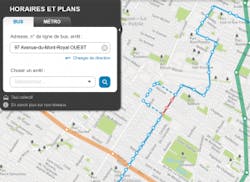STM and Transit collaborate on new tool for viewing current detours in STM’s bus network
In collaboration with Transit, the Société de transport de Montréal (STM) is rolling out a new tool for viewing current detours in the bus network. The new AI-based feature is now available in Beta on the home page of the mobile and desktop versions of the STM website, as well as in the Transit app. Customers can use it to better plan their trips by viewing alternate routes, as well as temporary and relocated stops.
The project was developed with C$200,000 (US$147,195) in financial support received through the Quebec government call for projects titled Soutien aux projets de démonstration et de vitrine technologique pour l’industrie du transport terrestre et de la mobilité durable, as part of the Innovation program, which is managed by Investissement Québec.
“We are developing this solution to meet a real need among our customers as we seek to leverage technology to improve the customer experience,” said Marie-Claude Léonard, CEO of STM. “We know that it can be difficult to keep track of detours in our extensive 500-square-kilometer (193-square-miles) network. Thanks to support from the Quebec government, we have taken the opportunity to work with Transit to develop an innovative, functional solution.”
“Detours have long been a major annoyance for our users,” said Sam Vermette, president and CEO of Transit. “We are happy to have developed this solution in collaboration with the STM and the Ministère de l’Innovation de l’Économie et de l’Énergie. The new feature automatically detects, analyzes and displays detours and temporary stops within an hour after they begin. This is a significant step forward for all Montréal public transit users, and we cannot wait to start working with our other partner transit agencies to integrate this technology into their networks as well.”
“The STM and Transit joint project demonstrates Quebec expertise in artificial intelligence, an important economic niche for the city,” said Pierre Fitzgibbon, minister of economy, innovation and energy, minister responsible for regional economic development and minister responsible for the Metropolis and the Montréal Region. “We are proud to support innovative public transit initiatives that help reduce our greenhouse gas emissions.”
A simple, intuitive interface
The new tool allows customers to locate out-of-service stops and their corresponding temporary stops. To use the tool via stm.info, STM customers can simply type their bus line number into the schedule search bar. The bus route will then be displayed in blue, with detours marked by a dotted line and out-of-service sections in red. If there are no red sections, the bus is running on its regular route.
In the Transit app, users can simply select their bus line. If any detours or temporary stops are detected, they will be shown on the map.
Putting AI to work for STM customers
Transit’s detour and temporary stop locator uses a statistical model trained on thousands of STM bus trips. This data comes from two sources:
Open location data from the STM
Real-time location data from people using the Transit app’s GO crowdsourcing function.
As soon as three vehicles in a row deviate from their regular route, Transit records the new route and begins showing it in the app. Using data on vehicle acceleration and deceleration, as well as the locations of existing stops in the area, the app detects and displays likely temporary stop locations.
On average, updated routes and stop locations are displayed in the app and on the STM website within an hour of the first vehicle’s deviation from its route.
Next steps
In a few weeks, app users will be invited to give feedback in a survey. They will also be able to submit comments in the Transit app.
After the trial period, the STM and Transit will analyze the feedback and assess the tool’s performance, as well as the accuracy of the information presented. The results will provide insight to help the STM consider how to proceed with a potential launch of a finalized version of the feature.
